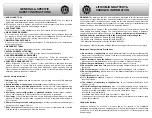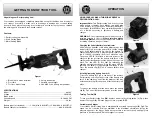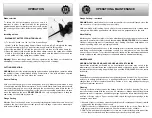
1. kNOW YOUR TOOL
Read and understand the instruction manual and labels affixed to the tool. Learn its
application and limitations as well as its specific potential hazards.
2.
Don’t use power tools in damp or wet locations or expose them to rain. Keep work area
well lit and provide adequate surrounding work space.
3. USE RIGHT TOOL.
Don’t force the tool or the attachment to do a job for which it was not designed.
4. WEAR PROPER APPAREL.
Do not wear loose clothing, gloves, neckties or jewelry (rings, watch) because they could
get caught in moving parts. Non-slip footwear is recommended. Wear protective hair
covering to contain long hair. Roll up long sleeves above the elbows.
5. MAINTAIN TOOL WITH CARE.
Keep tool clean for best and safest performance. Follow instructions for operation and
changing accessories.
6. DISCONNECT TOOLS.
Before servicing, when changing accessories or attachments.
7. AVOID ACCIDENTAL STARTING.
Make sure the switch is in the ‘’OFF’’ position before connecting battery.
8. USE RECOMMENDED ACCESSORIES.
Consult the manual for recommended accessories. Follow the instructions that
accompany the accessories. The use of improper accessories may cause hazards.
9. CHECk FOR DAMAGED PARTS.
Before further use of the tool, a guard or other parts that are damaged should be
carefully checked to ensure they will operate properly and perform their intended
function. Check for alignment of moving parts, breakage of parts, mounting, and any
other conditions that may affect its operation. A guard or other parts which are damaged
should be properly repaired or replaced.
Specific Safety Instructions
1. Only use
King attachments and accessories, serious injury can result if this warning is
not respected.
2. before installing or changing an accessory,
remove the battery from the tool.
3. Hold power tool by insulated grip surface,
an accessory could contact hidden wiring,
contact with a “live” wire will make exposed metal surfaces “live” and will shock the
operator.
4. Avoid body contact with earthed or grounded surfaces
such as pipes, radiators,
stoves and refrigerators. Risk of electric shock if your body is grounded.
5. Use clamps
or any other practical way to secure and support the workpiece to a stable
platform. Holding the work by hand or against your body is unstable and may lead to
loss of control.
6. Wear protective gloves and safety glasses,
an accessory can become extremely hot
during operation, danger of burns!
7. Do not use the tool
if switch does not turn it on or off. Any tool that cannot be controlled
with the switch is dangerous and must be repaired.
GENERAL & SPECIFIC
SAFETY INSTRUCTIONS
LITHIUM-ION bATTERY &
CHARGER INFORMATION
WARNING
: The warnings, cautions, and instructions discussed in this instruction manual
cannot cover all possible conditions and situations that may occur. It must be understood
by the operator that common sense and caution are factors which cannot be built into this
product, but must be supplied by the operator. Do not plug in charger or install battery into
saw until you have read and understood this instruction manual.
King canada offers a variety of 20V max Lithium-ion Power Tools which can all use the
same battery and battery charger. The obvious advantage is not having to purchase
separate batteries and chargers for each tool.
(battery and charger sold separately)
.
Available batteries and charger for this 20V max Li-ion Reciprocating Saw:
• 1.3 Ah 20V max Lithium-ion battery (Model K-020LBT)
• 3.0 Ah 20V max Lithium-ion battery (Model K-023LBT-3)
• 20V max Lithium-ion battery charger (Model K-020LCG)
Charging any other battery may damage the charger and possibly cause serious injury.
battery and Charger Safety Precautions
1) Do not store or carry battery
in a way which metal objects could contact the exposed
metal end of the battery. The battery could short-circuit causing a fire, personal injury
and damage to the battery.
2) Never attempt to open the battery
for any reason. If battery housing has cracked,
discontinue use immediately and do not try to recharge it. Dispose of battery.
3) Never charge a wet battery
or a battery that shows signs of corrosion.
4) Do not use an extension cord
with the charger, plug charger directly into a 120V AC
receptacle.
5) Do not use charger
if power cord is damaged, replace damaged cord or charger.
6) Do not charge battery
when work area or the battery temperature is or below 0
0
C or
above 45
0
C.
7) Unplug charger
when not in use.
8) It is important to recycle
or dispose of battery properly at your nearest battery
recycling location.
9) The contents of the battery is slightly acidic
, do not incinerate the battery, it can
explode in a fire.
10) A small leakage from the battery
may occur under extreme usage, charging or
temperature conditions. This does not indicate a battery failure. However, if the battery
housing is cracked and leakage gets on your skin, follow these steps;
-Wash with soap immediately.
-Neutralize area with mild acid such as vinegar or lemon juice.
-If leakage gets into your eyes, flush with clean water for a minimum of 10 minutes, then
seek medical attention.
Lithium-ion battery
Lithium-ion batteries do not have a memory and do not require to be completely
discharged periodically. After use, charge battery so that it is fully charged for the next time
you use this tool. A fully charged battery will only loose about 2% of its charge per month
during storage.






















